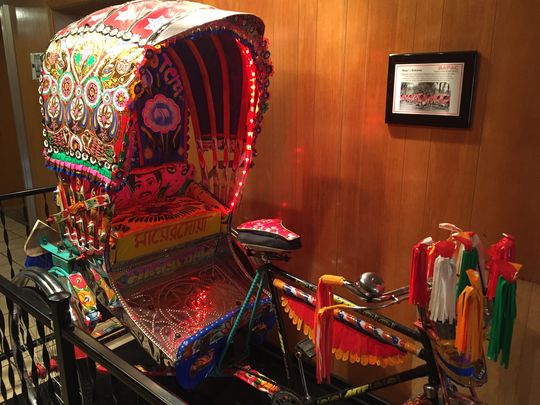
BanglaTown open for business: rebuilding Detroit’s neighborhoods
Steve Tobocman is the executive director of Global Detroit, which Knight Foundation supports. A version of this post previously appeared on the Global Detroit website.
The week before Thanksgiving, I was privileged to attend the ceremonial opening of the Bangladeshi American Public Affairs Committee office on Conant Avenue, the commercial main street of the BanglaTown neighborhood on the Detroit-Hamtramck border. Michigan Governor Rick Snyder provided the keynote address during the ceremony.
The event served as a milestone in the civic integration of the Bangladeshi community in Metro Detroit. It represented the culmination of more than a year’s worth of work by Global Detroit to help begin to brand BanglaTown as a cultural tourism destination. As Governor Snyder noted, “Cultural tourism is part of Pure Michigan, and it is what you are seeing here [in BanglaTown].”

Photo courtesy of Niraj Warikoo, Detroit Free Press.
The untold importance of the event from my perspective, however, is that it symbolizes the power that immigrants can bring to revitalizing a neighborhood and improving the quality of life in Detroit and the metro area. Governor Snyder went so far as saying, “What you’re doing here is making Michigan a great state. Diversity is a positive power… [and] Michigan is on the forefront of welcoming everyone to our state.”
I know that our city and state are spending tens of millions of dollars on blight removal, and that is understandable, as well as a needed part of improving our urban neighborhoods. But neighborhoods are not revitalized by blight removal alone. They are revitalized by people. Among America’s 50 largest cities, not one has lost population and then experienced population growth without growth in its immigrant population. Not one. And if Detroit wants thriving neighborhoods for working-class and middle-class and even low-income residents, it needs to invest in the BanglaTowns within its midst.
Simply put, immigration is the single greatest urban revitalization strategy in modern day America, and it’s one that doesn’t cost taxpayer dollars.
Lots of media was generated by the governor’s appearance. Some of that media focused on November’s election in Hamtramck, which made the Hamtramck City Council a majority Muslim body (perhaps the first majority Muslim city council in America). Another noteworthy aspect of the event news was the inclusiveness of the setting. I was proud to sit next to my friend, current Hamtramck Mayor Karen Majewski, who is the first mayor to sign up for immigrant-welcoming initiatives. Several Bangladeshi speakers acknowledged her leadership and contributions to welcoming and helping the Bangladeshi community. The Bangladeshi American Public Affairs Committee also acknowledged Mitch Cope and Power House Productions for the incredible work that he, his partner Gina Reichert and scores of artists—often whiter and more affluent than the other residents—have made in the neighborhood.
While I saw one headline suggesting that somehow the effort to brand BanglaTown was meant to replace Poletown, the reality is that the emergence of a BanglaTown adds to the strength of Poletown and Hamtramck’s multicultural past. I don’t see BanglaTown–a neighborhood that includes portions of northeast Hamtramck, as well as adjoining Detroit neighborhoods–replacing Poletown any more than Mexicantown has replaced or was meant to replace Motown. Hamtramck could be, should be and is inextricably linked with its Polish heritage, as well as its diverse ethnic makeup (which includes Bangladeshi, Polish, Bosnian, Yemeni, Ukrainian and African-American communities) and its diverse mix of artists and creatives.
November’s grand opening of the Bangladeshi American Public Affairs Committee office was just a milestone. Much more needs to be done to fully develop, integrate and build an inclusive community that captures the positive contributions of the immigrant community, as well as the strength of longtime BanglaTown residents. Global Detroit thinks BanglaTown is just one of several neighborhoods that can build more inclusive, revitalized communities. We look forward to partnering with Governor Snyder, the Bangladeshi American Public Affairs Committee, the Detroit and Hamtramck City Councils and others in revitalizing Detroit neighborhoods through immigrant inclusion.
- “Governor Snyder Joins Bangaldeshis in Opening Banglatown,” Detroit Free Press, Nov. 7, 2015
- “‘A Historic Moment’ for Hamtramck’s Growing Banglatown,” Michigan Public Radio, Nov. 6, 2015
- “Governor Snyder Taking Note of Hamtramck Growing Bangladeshi Immigrant Population,” MLive, Nov. 5, 2015
- “Snyder, Local Officials Open Bangladeshi Committee Office Near Hamtramck,” DBusiness, Nov. 6, 2015
- “Welcome to Banglatown! Bangladeshi Community Organization Office Opens,” Associated Press / CBS Detroit, Nov. 7, 2015
Recent Content
-
Artsarticle ·
-
Artsarticle ·
-
Artsarticle ·

